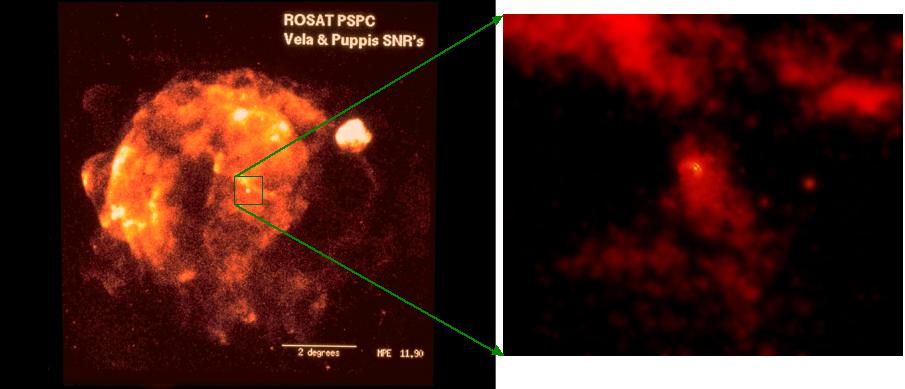
 Credit: Left: ROSAT Project and MPE; Right: NASA/SAO/CXC
Credit: Left: ROSAT Project and MPE; Right: NASA/SAO/CXC
The Vicinity of a Supernova
An explosion in the constellation of Vela occurred about 10,000 years ago,
leaving behind a large, broken
bubble of hot gas and a
rapidly spinning, dense stellar core known as a neutron star. To fully
understand this explosion and its aftermath, astronomers are faced with the
difficult problem of trying to understand the "big picture", without
glossing over important physical processes which occur on much smaller
scales. One way astronomers deal with this problem is to use a combination
of complementary observing tools. The image on the above left shows the
nearly spherical boundary of the supernova as seen in rather low-resolution
by the ROSAT satellite. This ROSAT
image allows astronomers to study the overall properties of the remnant
produced by the explosion, though in rather coarse detail. The image on
the right shows a closer view obtained by the Chandra x-ray observatory of the Vela
pulsar (the compact remains of the exploded star) along with the pulsar's
"wind nebula" and more distant clouds of million-degree gas produced by the
supernova. The Chandra image contains an enormous amount of data though
over a smaller region of the supernova remnant. By utilizing observations
with different spatial resolutions, astronomers are able to put together a
more complete picture of the nature of the stellar explosion.
Last Week *
HEA Dictionary * Archive
* Search HEAPOW
* Education
Each week the HEASARC
brings you new, exciting and beautiful images from X-ray and Gamma ray
astronomy. Check back each week and be sure to check out the HEAPOW archive!
Page Author: Dr. Michael F.
Corcoran
Last modified August 27, 2001


